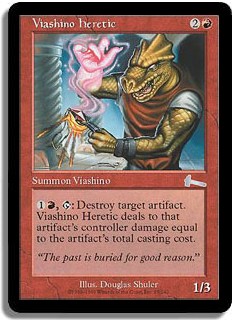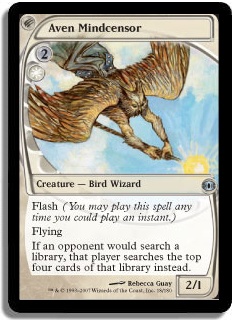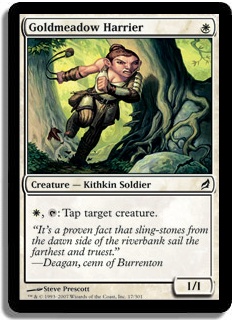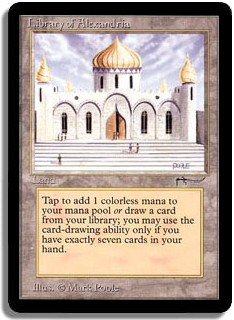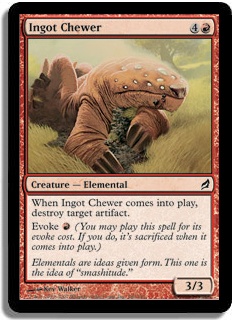AH! April is here, and oh how I love springtime. Especially if you’re a Michigander (or Northeasterner), you probably understand that the subsiding of the wind, snow, and cold (albeit this winter was mild compared to what’s normally to be expected) into the warmer, more temperate seasons is always a welcome change. Opening day for the Tigers has come and gone (they swept the Red Sox—which I’m sure Mike Guptil enjoyed).
For the record, I’m predicting the Tigers over the Phillies in the World Series this year. The NHL Hockey playoffs also just started up, and the Red Wings look primed to make another cup run, which is always fun to watch. But probably most importantly to anybody reading this article:Â spring means that the best months of competitive Vintage play are about to kick into gear!
Interesting fact: Stephen Menendian is also a Tigers fan; as a result, that organization has been renamed “Meandeck” Tigers.
In the last few installments of “Vintage Avant-Garde” I have focused on making an in depth analysis of the NEV metagame by looking for trends and proposing possible solutions. Today’s article is going to take a step back and look at some of the other metagame player’s that haven’t been discussed at length yet or are simply new and interesting to me. Some of these decks are pretty novel and cool, and I thought it would be fun to compile them together in one place to look at and talk about. I hope you won’t be disappointed!
Creatures (2)
Planeswalkers (2)
Lands (13)
Spells (43)
- 1 Brainstorm
- 1 Fastbond
- 3 Mana Drain
- 1 Vampiric Tutor
- 1 Mystical Tutor
- 1 Yawgmoth's Will
- 4 Force of Will
- 1 Sol Ring
- 1 Demonic Tutor
- 1 Hurkyl's Recall
- 1 Mountain
- 2 Island
- 1 Time Walk
- 1 Ancestral Recall
- 1 Mana Crypt
- 4 Gush
- 1 Merchant Scroll
- 3 Night's Whisper
- 1 Tinker
- 1 Black Lotus
- 1 Mox Emerald
- 1 Mox Jet
- 1 Mox Pearl
- 1 Mox Ruby
- 1 Mox Sapphire
- 1 Ancient Grudge
- 2 Empty the Warrens
- 1 Ponder
- 2 Mental Misstep
- 1 Flusterstorm

First of all, I absolutely refuse to call any of these decks by the goofy “pet deck” names you give them in the online forums. This is because it’s difficult for people to keep track of them (since they don’t specifically describe the deck they are talking about) and because it’s simply too confusing for laymen to know what you’re talking about. Naming decks should create a mental shortcut to being able to identify archetypes, not generate more confusion. So, regardless if people give their decks bizarre-o names like “The Piranha,” “Moldy Oranges,” or “Harold and Kumar Go to the Zoo,” I’m going to try and classify decks by archetype in my articles moving forward.
In any event, from what I understand Joshua didn’t actually give his deck the pet name “Black Magic,” somebody else did; I’m not trying to come down specifically hard on the name “Black Magic” as it’s a pretty cool nickname for a deck or whatever. It’s more of a general observation that I’ve made of the many of the decks I’ve encountered while researching this article: almost every deck has a weird and mostly irrelevant nickname that complicates rather than simplifies understanding of what is going on in the metagame.
Anyways, all joking aside Joshua has constructed a very nice blue deck here, and I strongly approve of what he has put together—especially with regard to the heavy Workshop / Fish metagame that has been unfolding in the Northeast.
Key components to this deck include the revival of playing with Mana Drain and Jace, the Mind Sculptor, but this time in a Gush / Combo shell. The deck reminds me a lot of the Drain Tendrils decks of yesteryear, with regard to the role it’s likely to play from matchup to matchup. This deck has more ways to meaningfully interact with relevant strategies. He has a whole slew of awesome ways to combat MWS (Mishra’s Workshop) in the forms of Hurkyl’s Recall, Jace, the Mind Sculptor, Ancient Grudge, and (wow) Viashino Heretic. He also has Empty the Warrens, which seems to be pretty sweet technology for putting on the brakes against Noble Fish decks.
“Playing Viashino Heretic in the maindeck of Gush Storm is F-I-L-T-H-Y.”
The other cool piece of technology from this deck is that he’s made a pretty bold choice in replacing Preordain (which I remember Smennen saying: If you play Gush you play 4 Preordain, a statement I also rubberstamped as being very reasonable) with Night’s Whisper, a card that what it gives up in speed it replaces with V-A-L-U-E and card advantage. Night’s Whisper functions like the Dark Confidant in the Bob/Gush decks, but it gives you the advantage all up front at the cost of not providing a 2/1 body.
Particularly, the 2/1 body in a field full of Swords to Plowshares, Lightning Bolt, and Dismember aimed at the faces of Lodestone Golems and Trygon Predators seems less of a boon than a drawback; with people stocking up on Nature’s Claims and other permanent-aimed removal in place of Flusterstorms, Night’s Whisper seems like a gambit that Joshua has proven can pay off in spades against the right field of decks.
This is a Gush deck that I could see myself playing at some point, and I am not a big fan of playing with Gush. Excellently built and positioned deck; I give it an A+.
Creatures (22)
- 2 Kataki, War's Wage
- 4 Aven Mindcensor
- 2 Goldmeadow Harrier
- 4 Stoneforge Mystic
- 4 Leonin Relic-Warder
- 1 Gideon's Lawkeeper
- 2 Grand Abolisher
- 3 Thalia, Guardian of Thraben
Lands (16)
Spells (22)

The first observation that I’d like to make about the tournament feedback I was looking at from the LCV tournament was that there was a lot of Aven Mindcensor in the Top 8. While I haven’t seen Avenmindcensor pop up too much in the Northeast, it could be something that the Vintage die-hards might want to be testing and solving for the upcoming months. There are more Mindcensors in the LCV Top 8 than Workshops or Gushes!
“Will Aven Mindcensor be the next Trygon Predator!?”
Anyways, the mono-white creature deck basically functions around the premise of: “How can I make my deck as absolutely frustrating for my opponent to play against as possible?” I strongly approve of utilizing this tactic whenever possible. Almost every single spell in the deck attacks the opposing deck’s ability to do something or execute some angle of their game plan—the hope is that after enough angles have been negated that the white mage will have bodies to finish off the crippled opponent.
The white deck is basically maxed out with strategic trumps to every key linear match up one would expect to face in a long Vintage event:Â Grafdigger’s Cage for Dredge, Thalia for Gush, and Kataki for MWS.
One thing that I think about when I see a deck like this is that perhaps there’s a place for Enlightened Tutor somewhere nearby just waiting to be discovered. It would certainly open up some options with regard to maindeck and sideboard bullets:
“These are all annoying Enlightened Tutor targets that would feel at home in the mono-white deck!”
Also, I know many of us have all been losing sleep the past year looking for a place where Gideon’s Lawkeeper and Goldmeadow Harrier could team up and be awesome in Vintage; fortunately, the riddle has finally been solved and we can all sleep easy now.
“It’s time to add these ‘bad boys’ to the Comprehensive Vintage Checklist.”
Creatures (9)
Planeswalkers (3)
Lands (11)
Spells (37)
- 1 Sensei's Divining Top
- 4 Mana Drain
- 1 Plains
- 4 Force of Will
- 1 Sol Ring
- 4 Island
- 1 Time Walk
- 1 Ancestral Recall
- 1 Mana Crypt
- 1 Thirst for Knowledge
- 1 Aether Spellbomb
- 1 Black Lotus
- 2 Fact or Fiction
- 1 Mox Emerald
- 1 Mox Jet
- 1 Mox Pearl
- 1 Mox Ruby
- 1 Mox Sapphire
- 1 Engineered Explosives
- 3 Spell Snare
- 1 Nihil Spellbomb
- 3 Mental Misstep
- 1 Grafdigger's Cage

It’s been quite some time since a “Bomberman” decklist has made an appearance in once of my articles, so this is probably well overdue.
It’s really interesting to me that this deck just has three Aven Mindcensors jammed into the maindeck, and to be honest I can’t really explain to you why or even whether or not it’s good or bad (at least not definitively yet). As I stated before, this particular Top 8 has a ton of Aven Mindcensors floating around, so it might just be a regional thing—but it could also just be that this group has stumbled onto the fact that this particular card is better than anybody else is giving it credit for. Sure, it’s also possible that Mindcensor is being overvalued, but if some people are over valuing it and others are undervaluing it then the truth probably lies somewhere in the middle, which could realistically mean that everybody else is undervaluing how good this card can be.
Aven Mindcensor aside, the Bomberman deck is really controlling compared to decks that have been performing well in the NEV Series. The deck has three Jace, four Drain, Gifts, and two Fact or Fiction! I don’t think anybody has played two Fact or Fiction and Gifts Ungiven since I mistakenly did it at Waterbury last year! Oh, and he has Library of Alexandria!
“It still taps to draw a card, even if most people don’t play it anymore!”
The Bomberman has four Trinket Mages and a whole slew of Tutorable 0CC and 1CC artifacts to get with him, including one Grafdigger’s Cage—which I remember really liking as an application for that card right off the bat while I was writing my Dark Ascension set review with Mark Hornung.
There are also a lot of counterspells packed into this deck:
4 Force of Will
4 Mana Drain
3 Mental Misstep
3 Spell Snare
That’s a lot, so if you really like to counter everything and then hang out and draw cards, then this might be a deck you’d want to sleeve up at some point in the future. Although, I can’t help but feel that a deck like this would greatly benefit from playing with Snapcaster Mage somewhere, somehow, in some number in the 75 (probably the main 60).
Creatures (9)
Planeswalkers (2)
Lands (13)
Spells (36)
- 1 Sensei's Divining Top
- 1 Brainstorm
- 3 Mana Drain
- 1 Vampiric Tutor
- 1 Mystical Tutor
- 1 Yawgmoth's Will
- 4 Force of Will
- 1 Sol Ring
- 1 Demonic Tutor
- 1 Hurkyl's Recall
- 2 Island
- 1 Time Walk
- 1 Ancestral Recall
- 1 Mana Crypt
- 1 Time Vault
- 1
- 1 Merchant Scroll
- 1 Tinker
- 1 Voltaic Key
- 1 Black Lotus
- 1 Mox Emerald
- 1 Mox Jet
- 1 Mox Pearl
- 1 Mox Ruby
- 1 Mox Sapphire
- 3 Mental Misstep
- 2 Flusterstorm
Sideboard

Ryan’s Grixis deck can really do a lot of almost everything you need it to! He’s pretty much found a way to squeeze everything but the kitchen sink into this brew: Jace, Key-Vault, Tinker-BSC, Bob, Snapcaster, Drains, Library, Academy, Top, Clique, Fire / Ice, Hurkyl’s, and Will. When I was looking at the list for the first time, I wasn’t even sure how it was possible and made sure to count his maindeck to check and see if it was 66 cards!
It wasn’t, but what I soon figured out was that he has no Preordains or Ponders and only 22 mana sources (including off-color Moxes and Library!), which allows him to play so many spicy spells. It’s interesting to me that both Ryan’s Grixis deck as well as Joshua’s Grixis deck both cut the 1CC blue library manipulation in lieu of playing 1B card advantage spells (in this case, Bob and the former, Night’s Whisper), and that both are playing Jace and Drain.
I had never really considered playing this archetype this way, by cutting mana and 1CC spells, but apparently Ryan got it to work out pretty well for him at this event. I like the idea of not needing to play with Ponder or a bunch of Preordains, especially if Thorns and Spheres are going to make it difficult to gain much value out of these cards. But I do worry that cheating way down on lands might be dangerous.
I would probably cut the Library (sorry to be the Fun Police) and one other spell for two fetchlands simply to provide a bit more consistency among starting hands and actually draw land when it’s needed. However, aside from the mana base, I really like everything else that this deck is trying to do; it plays a lot of powerful spells, it has solid defensive cards, it can protect its own threats, and it has Snapcaster and Dark Confidant to get card advantage.
Another thing I’d like to point out is that a lot of the blue decks have been moving more heavily towards playing red, and one of the key reasons I believe this is happening is for this guy:
“Best red card in Vintage?”
Almost nobody who plays Vintage in the entire world shares my enthusiasm for playing four- and five-color mana bases and getting to play Ancient Grudge; I totally understand that. Nonetheless, for those of you that don’t enjoy City of Brass, it seems as though there’s beginning to be some consensus that Ingot Chewer is the card that people with straightforward Grixis mana bases bring in as the “best possible card” of choice against Workshops.
It’s noteworthy that both of the Grixis decks featured today are overloaded with Ingot Chewer out of the sideboard, and it’s my belief that if Grixis is able to carve out a place for itself amid the Workshop decks floating around that Ingot Chewer will be playing a big part.
Summary:
- Do Ponder and Preordain suck right now?
- Is Aven Mindcensor the real deal?
- Grixis or Bant: who is going to win?
- Is big mana U/W Control a real thing moving forward?
- How many mono-white hate bears are too many?
Only in a rogue deck article!
Thanks for reading, Â Â Â Â
Brian DeMars

